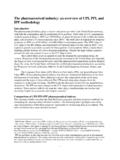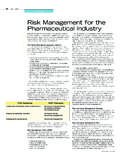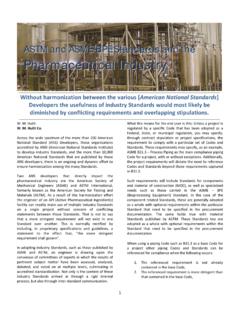Transcription of The Pharmaceutical Biotechnology Industry in France
1 The Pharmaceutical Biotechnology Industry in France French Ministry of Research and New Technologies Technology Directorate Bio-engineering Department January 2004 by Alain Rochepeau Economiste Minist re de la Recherche Direction de la Technologie 2 TABLE OF CONTENTS INTRODUCTION .. 5 Objectives .. 5 Approach .. 5 National characteristics .. 7 Context and general environment, situation and 7 Main industries .. 9 The Pharmaceutical Overview .. 10 French groups .. 12 French Independent 12 Foreign groups .. 12 13 Labour force .. 13 Technological 15 Commercial 15 2. NATIONAL POLICIES TOWARDS R&D AND TECHNOLOGICAL 17 Main actors in public policy .. 17 Main measures to support The 1999 Innovation Act .. 18 Incentives for the development of 20 First impacts of 20 The 2003 Innovation Plan .. 21 The new status of "business angel".
2 22 Aid for R&D projects conducted by "young innovative firms" .. 22 New aid aimed at innovation .. 22 "Foundation of a Scientific Nature".. 23 Simplification of aid for innovation .. 23 Practical measures to better capitalise on R&D in firms and laboratories .. 23 3. STRUCTURE, DYNAMICS AND PERFORMANCE OF THE Biotechnology SECTOR IN 24 Public research .. 24 The private Biotechnology sector (a3-a5) ..24 Situation .. 24 Trend in start-ups and failures (E26) .. 27 The international dimension (d20-d21).. 27 Performance (a5) .. 28 4. THE DYNAMICS OF INNOVATION .. 30 3 Knowledge potential (Ba8, Ba9) .. 30 Human resources (Ba9, Ba10).. 30 Financing (b11-b14) .. 32 Public funding by research and technological innovation networks .. 32 Other sources of public financing: ANVAR and Research Tax Credits .. 32 Venture and seed capital funds.
3 33 Private financing (b11 & b14) .. 33 Legislation and regulations (Bc15 and Bc16) .. 36 Starting up a firm (Bd17 and Bd19) .. 36 5. MARKETS .. 38 Situation in the French market .. 38 Market administration (G33 & G34) ..39 Organisation of the national healthcare system (H35& H36) .. 39 Intermediaries and prescribers (I37).. 39 Consumers (J38 & J39) .. 40 6. OUTLINE 42 Opportunities for the Pharmaceutical Biotechnology 42 Current status of the driving force for innovation .. 42 Strength of the French Pharmaceutical Biotechnology 43 Opening up the system .. 43 The role played by demand .. 43 Policy implications .. 44 4 LIST OF TABLES AND FIGURES Table Macroeconomic indicators Table Indicators of R&D and innovation in all areas Table Main industries Table Top 20 French Pharmaceutical firms in 2002 Table Number of Pharmaceutical companies Table Main mega-mergers involving French companies Table Start-ups/failures of companies in the Pharmaceutical Industry in the "drug manufacturer" category Table Share of the French market held by foreign groups in 2000 Table Top 20 French Pharmaceutical firms by number of employees in 2002 Table Top 20 resident French groups in terms of exports in 2002 Table Annual national for R&D in the life sciences Table Main activities of Biotechnology firms in the health sector Table Number of firms and employees in the Biotechnology and
4 Pharmaceutical sectors Table Specialties of biotech firms in the human health sector in 2000 Table Trends in R&D expenditure 1995-1999 Table Start-ups of Biotechnology firms from 1980 to 2001 Table Strategic alliances entered into by leading French Biotechnology firms 1995-1999 Table Performance of Biotechnology firms Table Status of the Biotech Sant Humaine pipeline of French Biotechnology firms in 2002 Table Status of the Biotech Sant Humaine pipeline of French Biotechnology firms in 2003 Table French scientific output Table Employment in the Pharmaceutical Industry Table Comparison of social contributions in a selection of European countries Table Impact of national research and technological innovation networks on the Biotechnology sector (2000-2003) Table Breakdown of R&D in the French Pharmaceutical Industry in 2000 Table Sources of investment in French Biotechnology firms in 2002 Table Rates of taxation in a selection of European countries Table Impact of the national competition and incubators on the creation of Biotechnology firms specialised in healthcare Table Growth in the number of doctors in France (2002) Table Per capita spending on drugs and medicines in the OECD area (2000) Table Impact of policies aimed at the creation of innovative firms in the Pharmaceutical Biotechnology sector 5 INTRODUCTION Objectives This report has been drafted for the Working Party on National Policies towards Innovation in the Biotechnology Sector.
5 The aim of this Working Party is to determine and describe innovation structures and mechanisms in the Pharmaceutical sector in order to establish, on the basis of national analyses, the public policy components or actions likely to prove effective in furthering the development of Biotechnology . This report therefore consists primarily in an overview of the sector describing the economic environment, the Pharmaceutical Industry , research, national and sectoral policies, the actors involved, and the cultural, socio-economic and regulatory contexts of the market. The purpose of this description is to identify all the factors which stimulate or constrain the dynamics of the sector so that, by gaining a greater insight into the distinctive dynamic properties of the system, a number of axioms can be formulated independently of specifically national characteristics in order to provide a basis on which to recommend public policies to promote the development of the Biotechnology Industry .
6 These axioms will therefore be formulated on the basis of the national reports from individual OECD Member countries, whose presentations are governed by a charter drawn up by the Working Party and common to all participating countries. These national sectoral reports will therefore allow the OECD to establish an initial analysis that will attempt to answer the following question: Is it possible to identify the main differences and similarities in the structure and dynamics of national Biotechnology innovation systems between OECD Member countries which would explain the performances of those systems, and what are the implications in terms of public policy? This analysis has been conducted and presented according to the same procedure by the individual countries participating in this Working Party, namely: Belgium, Finland, Germany, Japan, Netherlands, Norway and Spain.
7 Approach The structure of this report is based on that set out in the "Guide Book" (December 2002) drafted by the OECD Working Party on Innovation Systems in the Field of Biotechnology . France joined this Working Party in November 2003. The approach can be broken down into four lines of enquiry: 6 A descriptive analysis of the national innovation system for Biotechnology . This section describes the actors (organisations) involved in the Pharmaceutical Biotechnology innovation system, their relations, actions and conditions of involvement. An analysis of patents and published papers in order to establish an overview of the performance of the national Biotechnology system, with indicators that can measure the scientific and technical output of the system. A survey of partnership arrangements between firms.
8 In addition to seeking information on the structure of Biotechnology innovation systems, the survey should ask firms in the Pharmaceutical sector to describe their strategy towards co-operation with other firms as well as universities and research organisations. Interviews with selected firms, experts on the sector and market actors. The French report follows this approach by drawing on information and data sets taken from the existing literature, and primarily the large volume of statistical and survey data available. The main sources of the data aggregated in this report are as follows: OECD; INSEE (National Institute for Statistics and Economic Studies); Xerfi; Ernst Eurostaf; French Ministry of Industry ; French Ministry of Research; French Ministry of Education; ANVAR (French Agency for Innovation); LEEM (Les Entreprises du M dicament); France Biotech; European Union; Cofacerating; Caisse des D p ts et Consignations; OST (Science and Technology Statistics Office); Chambers of Commerce and Industry ; Social welfare agencies; Euronext.
9 7 National characteristics Context and general environment, situation and prospects Sources: OECD, INSEE; Economic background and prospects for potential growth On 1 January 2003, metropolitan France had a population of million inhabitants, making France the 21st largest country in the world and the 3rd largest country in Europe after Germany and the United Kingdom. In addition, a further million people live in France 's overseas d partements. France 's gross domestic product in 2002 amounted to EUR 1 520 billion. The rate of growth in the French economy ( in volume, and in 2001) is well below the average within the OECD area. Household consumption is only rising slowly in volume terms and this particular engine for growth appears to be at a standstill.
10 Despite a relaxation of budgetary policy, France is experiencing an economic and structural slowdown and has one of the highest unemployment rates in Europe. Table Macroeconomic indicators Total population in 2002 61 231 million inhabitants GDP in 2002 EUR 1 520 billion (1) Imports in 2002 EUR 380 billion (1) (2003S1 = EUR 200 billion FOB) Exports in 2002 EUR 412 billion (1) Variation in GDP in volume terms in 2002 + Variation in imports in volume terms in 2002 + Variation in exports in volume terms in 2002 + Unemployment rate (June 2002) (1) Nominal value (2) Constant prices compared with the previous year Source: INSEE. From 1989 to 1999, total salaried employment in France grew at an annual rate of , increasing by a total of over the period. At the beginning of 2002, metropolitan France had a labour force of million workers (as defined by the ILB), consisting of million employed workers and million unemployed.















